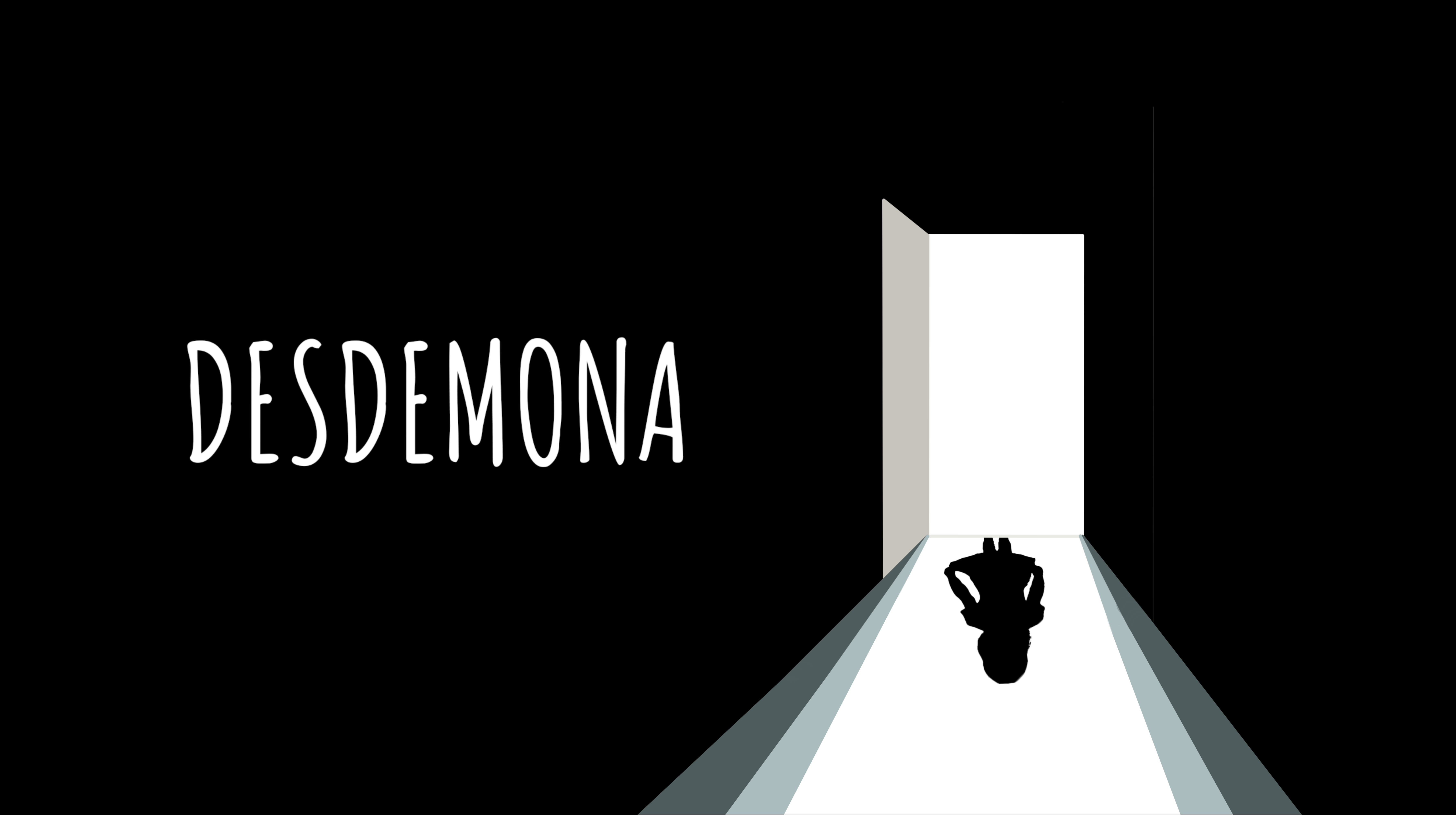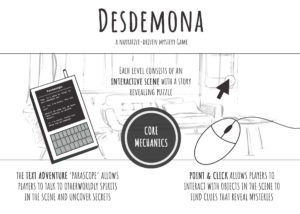Created by Grace Zhao, Graham Todd, Josh Lara, and Saljuk Gondal.
Artist’s statement
Desdemona is a cross between classic point-and-click adventure games and a chatbot with a supernatural twist. Players take the role of someone returning to their hometown after having been away for many years, finding that much has changed in their absence. The game takes place in an abandoned house, which players explore with the aid of a mysterious device called a “parascope.” This device allows players to communicate directly with whatever presence now resides within the house, which is crucial for uncovering all the mysteries of what happened.
We decided on the mechanic of the parascope because we enjoy the freedom of player expression that text interfaces afford. In addition, we wanted to incorporate visual elements to help better convey a sense of melancholy and to expand the range of potential puzzles we could use. Ultimately, the challenges in Desdemona require both interfaces to solve.
Beyond just the fun of solving puzzles, we made Desdemona because we wanted to capture the particular subtle sense of sadness you have on realizing that you’ve grown away from the place you once called home and the people who used to define your life. We hope Desdemona offers something to anyone who, like us, has felt this way.
Initial Concept
MOODBOARD
We wanted our game to be beautiful visually while conveying a unique combination of melancholy and mystery. We took inspiration from these photos to help us get right the wistful beauty of an old, abandoned house that was clearly a space of love and life in its prime. 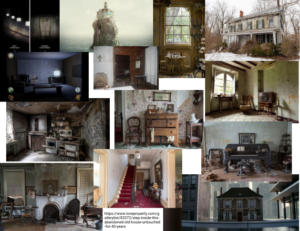
PLAYLIST
The songs we chose in our Spotify playlist, primarily slow piano songs, also help immerse players in the mood of melancholic mystery.
MAP
This map shows the game mechanics and how players will interact with them.
Formal Elements and Values
FORMAL ELEMENTS
Desdemona is a single-player game in which the player’s objective is to solve puzzles in order to unearth the developing narrative. The outcome is non-zero sum: players finish the game by uncovering the complete story of what happened in Desdemona.
The game’s procedure is a combination of point-and-click and text input with a chatbot; to solve puzzles, players must click on specific objects in the 2D environment as well as communicate with the “ghost” through the parascope’s text interface.
The boundaries of the game are constrained to the Desdemona game application and the space where players experience the immersive audio of the game.
TYPES OF FUN
Desdemona evokes many types of fun! Through uncovering a mysterious and riveting plot, players experience the fun of narrative and discovery. Players also experience the fun of challenge when solving the embedded puzzles in the narrative. Finally, the chatbot feature allows players (to a certain capacity) to express themselves, which is fun through expression.
ONBOARDING
We implemented a tutorial section at the beginning of the game. Through click-through messages, we establish that
1. The parascope can be used to communicate with spirits
2. The game is a point-and-click
Since we implemented a vertical slice, we also
3. Establish context for the game’s narrative up to our current state
In this tutorial we also have players type a simple message in the parascope and have an initial basic conversation with the ghost Kathie to reiterate point 1. Finally, we have players click on the entrance door to begin the first puzzle to reiterate point 2.
BALANCE
Since our target audience is young adults and up, including veteran gamers as well as novices, we paid great attention to achieving a level of difficulty that was fun yet challenging for all players. We did this in two ways: through mixing elements of different difficulty levels and through an adaptive hint system.
The first is achieving a good mix of difficulty levels. This also meant that the pacing of the game had some variety. The first puzzle is multistep: players almost always first find the first and last name of Kathie, which is quite easy; finding the middle name is harder. The second puzzle expands on complexity by adding more interactive objects in the environment and a different style of puzzle (riddle).
The second is through an adaptive hint system. For players who find the game more difficult, they can find hints in several ways: the ghost will offer hints automatically every 60 seconds, tailored to the player’s current progress; players can also directly ask the ghost for help by typing in the parascope.
CORE LOOPS
Each room is a self-contained puzzle with its own interaction arc. There is an emotional and narrative payoff at the end of each arc through concluding text popups and dialogue.
Players may have interaction loops within the rooms by going back and forth between conversation with the ghost Kathie and examining and interacting with clickable objects in the room.
TONE
As we have mentioned before, we wanted to evoke a sense of melancholy and mystery. Mystery was quite easy to evoke, as the player has to uncover the narrative and is consistent with the audience’s expectation for this kind of game.
However, we had to put in a lot more work to really get the feeling of melancholy across. To do this, we leveraged color, by using muted shades and a blue tinge to convey somber, and sound, by using old-fashioned, melancholic piano tracks and sounds effects. We also designed the context surrounding the narrative to show that the protagonist has a past personal connection to the space as well as to Kathie.
Playtesting and Iteration
ITERATION 1
Our first iteration of Desdemona was based on art we found online, alongside a simple version of a chatbot for the ghost.
Playtest dates: 5/6/21, 5/12/21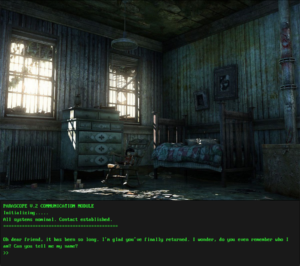 In our first version, we attempted to capture the core mechanics and feel of the game. We knew we wanted to set a melancholy tone and incorporate our idea of a semi-intelligent chatbot, and so we quickly put together an implementation based on a photo of a rundown bedroom, point-and-click interactives, and a simple conversation system.
In our first version, we attempted to capture the core mechanics and feel of the game. We knew we wanted to set a melancholy tone and incorporate our idea of a semi-intelligent chatbot, and so we quickly put together an implementation based on a photo of a rundown bedroom, point-and-click interactives, and a simple conversation system.
Observations/Thoughts:
Players were impressed with the game and in particular, had a fun time solving the puzzle of Kathie’s name. However, there was also a slew of issues that we noticed, one of which being that players had a very hard time figuring out there was a point-and-click aspect to the game. The textbox at the bottom gave off the impression that it was the only mode of interaction! Additionally, while some playtesters solved the puzzle relatively quickly, others became stuck and required outside help to finish successfully. Finally, our intended tone was not quite there yet – playtesters reported feeling a sense of discomfort and creepiness, but not the sense of melancholy – one playtester reported “it needs some sense that you were happy in that location.”. When asked how we could better evoke melancholy, playtesters expressed strongly about wanting to learn more about Kathie as well as how the protagonist has a personal connection to her.
“It needs some sense that you were happy in that location”
Recommendations:
- Incorporate ways to clue the player into the point-and-click aspect.
- Create a hint system.
- Expand artwork and dialogue to evoke melancholy and less creepiness.
ITERATION 2
Our second iteration featured a hint system and stunning hand-drawn art!
Playtest dates: 5/13/21, 5/18/21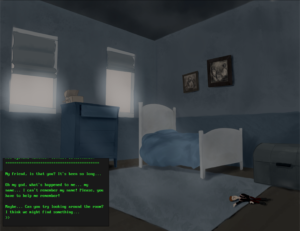 We greatly improved upon Desdemona for our next playtesting iteration. Our first concern was to improve upon the tone of the game. Our biggest change to this effect was the addition of custom artwork, which was colored in a mellow blue aesthetic to hopefully evoke a better sense of melancholy. Furthermore, we made extensive updates to the ghost’s dialogue, making her come off more like a morose old friend rather than a malicious opponent. To even out the difficulty, we also added a hint system that would offer the player useful information every 60 seconds. We also attempted to address the issue of the point-and-click aspect not being noticed but were concerned about breaking the immersion of the game. In the end, we decided to have the ghost prompt the player to “try looking around the room” at the start of the puzzle.
We greatly improved upon Desdemona for our next playtesting iteration. Our first concern was to improve upon the tone of the game. Our biggest change to this effect was the addition of custom artwork, which was colored in a mellow blue aesthetic to hopefully evoke a better sense of melancholy. Furthermore, we made extensive updates to the ghost’s dialogue, making her come off more like a morose old friend rather than a malicious opponent. To even out the difficulty, we also added a hint system that would offer the player useful information every 60 seconds. We also attempted to address the issue of the point-and-click aspect not being noticed but were concerned about breaking the immersion of the game. In the end, we decided to have the ghost prompt the player to “try looking around the room” at the start of the puzzle.
Observations/Thoughts:
Our playtesters enjoyed this version of the game and liked the “escape room” feeling. The puzzle itself continued to be just the right level of challenging, with playtesters following our intended “path” through the puzzle to find out the ghost’s name. They also appreciated the new artwork and reported that it fit the melancholy tone very well! Unfortunately, the playtests also revealed several problematic areas, most based on the onboarding and mechanics. Our attempt to suggest that the room was clickable did not fully work, as some playtesters took a long time to figure it out despite the tip. Additionally, our chat interface was misconstrued as a text adventure interface (which was a fair assumption!). We also received input that while already immersive, the game would benefit from additions like music.
On May 18th, we had the fortune to receive advice from game designer Laura Hall on our game. She made a huge emphasis on the importance of onboarding and recommended that we make an explicit introductory section to introduce players to the narrative context and game mechanics (point-and-click, typing) one at a time.
“I wasn’t sure whether the game was about typing, or clicking, or both”
Recommendations
- Create a full onboarding introduction for core mechanics.
- Add visual/audio improvements for immersion.
ITERATION 3
Our third iteration added audio for all interactives, a more immersive border for the parascope, and an introductory onboarding scene to ease players into the mechanics and narrative of the game.
Playtest date: 5/20/21

By this point, there was only one real problem from our playtests that we aimed to resolve: the onboarding. Following Laura Hall’s recommendation, we added a linear introduction that introduced the player to the game’s narrative, typing mechanic, and point-and-click mechanic. To even progress to the first puzzle, the player would first need to: read the initial context, type into the parascope, write their name to the ghost, and click on the bedroom door. Together, these would acclimate the player to the game’s tone and mechanics in a simple environment. Our other changes pertained to improving the existing atmosphere. We added on-click audio effects to interactive objects in the room, with the hope that the rattles of windows and creaking of drawers would create a sense of immersion. We also created a hand-drawn border around the parascope and created an animation for opening and closing it, thus integrating our existing textbox into the universe of the game.
Observations/Thoughts:
After playtesting, we found that the onboarding was effective in introducing the narrative and core mechanics of the game. We received some comments that the sequence felt a little too long, but overall we were very happy with how it turned out! Our last feedback that we felt we needed to act on was improving the story. One playtester was confused over who exactly Kathie was, saying “It feels this person is related to me in some way… but it’s someone else’s room/house?” Playtesters wanted to know more about why the protagonist came to town, what their relationship was with Kathie, and what their goal was.
“It feels this person is related to me in some way… but it’s someone else’s room/house?”
Recommendations:
- Add another puzzle and room to the game – this would shed more light on Kathie, her death, and her family.
ITERATION 4
We added another fully realized room and puzzle for the fourth iteration!
Playtest dates: 5/23/21, 5/24/21
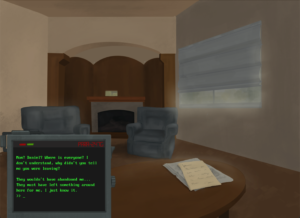
As planned, our fourth iteration introduced a new room and puzzle, along with corresponding art, audio, and writing! This puzzle was based on solving a riddle that Kathie’s mother left for her. The clues to this riddle revealed new information about Kathie’s death and her family life. We wanted to incorporate both the text interface and point-and-click interface, but introduce a new twist on them. For the text-based parascope, we brought back Kathie as the ghost with which the player would talk, but this time with new dialogue that would help in solving the current puzzle. For the point-and-click portion, we created a dynamic, interactable radio object that would need to be used to input the solution of the riddle. Our aim in this iteration was to add more content to the game, which would alleviate previous feedback about players wanting to see more of the story.
Observations/Thoughts:
Playtests were run on the game as a whole, but were especially examined with regard to Puzzle 2. Thankfully, most reported issues were no longer about core mechanics and narrative, but instead about mechanical details, like about how “the radio knob felt finicky to turn.”
We made continuous small iterations during this playtest period to adjust Puzzle 2’s riddle difficulty, the presentation of the clues, and the technical mechanics of the radio. Overall, we were quite happy with this version of Desdemona as a submittable product!
Recommendations:
- Improve the spirit’s dialogue and potential number of responses (again)
- Continue adjusting the puzzle difficulty and make radio mechanics more clear
Final Playtest
Play Desdemona
Click here to download the Mac Version
Click here to download the Windows Version
If you are running the game on a Mac and encounter an error with permission, follow the instructions linked here.
Walkthrough/Puzzle Guide
INTRO
- Click or press any key to go through the textboxes and get caught up on the game’s context.
- When prompted, press CTRL to bring up the parascope. Type anything and hit enter to proceed.
DOORWAY
- Click or press any key to advance up to the point where the parascope lights up.
- When prompted, type in your name to establish communication with the ghost.
- Follow the ghost into the bedroom by clicking on the bedroom door.
BEDROOM – PUZZLE 1
The nature of this puzzle is to use the objects in the environment and your communication with the ghost (via the parascope) to determine the ghost’s name. To piece together the clues,
- Click on the drawer to bring up the ghost’s diary. The diary will prominently display the name “Kathie” on its front. Type “Kathie” into the parascope and the ghost will confirm that it’s her first name.
- Click on the first picture on the wall that has only one person on it. The picture’s description shows the initials “K.E.J”. Those are Kathie’s full initials.
- Click on the doll on the floor (next to the chest). The doll’s description will show that it belongs to “Daniel Johnson”. The ghost will confirm through the parascope that Daniel was her brother. This, combined with the ghost’s initials, will allow you to guess that the ghost’s name is “Kathie Johnson”. Type this name into the parascope for Kathie to confirm. You now only need to find her middle name, which you know starts with an E.
- Click on the second picture on the wall with multiple people on it. Kathie will tell you through the parascope that the picture shows her and her brother, and how they would always play pretend like the kings and queens in England (like Queen Elizabeth). This information, combined with the knowledge that Kathie’s middle name starts with E, should allow you to guess “Elizabeth” as her middle name. Type that in the parascope and Kathie will confirm. Follow her as she moves to the living room.
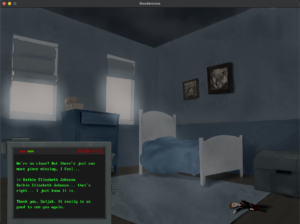 Puzzle 1 Solution: Full name is Kathie Elizabeth Johnson
Puzzle 1 Solution: Full name is Kathie Elizabeth Johnson
Note that there are other objects in the room, like the chest and the music box that are also interactive. While they don’t divulge any information that goes towards the puzzle, they were made interactive to increase the number of active objects in the room (to retain the player’s interest) and as a way to heighten the puzzle’s challenge by effectively creating red herrings. Additionally, these artifacts were also created with the intention to return to them later on in the full game (e.g. in the full game, someone might return to Kathie’s room, later on, to open her chest with a found key). Finally, there are also additional hints that Kathie might remember that could help you solve the puzzle if you spend too long being stuck. This is part of the game’s adaptive hint system.
LIVING ROOM – PUZZLE 2
The nature of this puzzle is to use the objects in the environment and your communication with Kathie to determine the secret radio frequency at which Kathie’s mom has left a message. To piece together the clues,
- Click on the note on top of the table and read through it. You’ll learn that Kathie’s mom has left the house, but left a secret message for you and Kathie in the usual spot.
- After putting down the note, Kathie will ask you about the note and what her mom said. Tell her that “She left a secret message”. This will prompt Kathie to remember a riddle that she was taught as a child. The answer to the riddle will help you find the radio frequency where the message is stored. Kathie will also periodically hint that the answer is interacting with the radio to guess the right frequency.
- The radio frequency consists of two numbers, both of which are clued in the riddle. For the first number, Kathie tells you “The first, my dear, is forty more than the year in which you’re born.” This means that the first number is 40 more than the year of Kathie’s birth. To find the year Kathie was born, click on the newspaper on the table. The headline will tell you that Kathie died a year ago (i.e. 1970) at the age of 14. This means she was born in 1956. 40 plus 1956 is 1996, which gets you the first number.
- For the second number, Kathie tells you that it’s the number of people in their family. After the riddle, Kathie will repeatedly tell you that it’s only been her, Daniel, and mom in the house since their dad left. This means that there are 3 people in the family.
- Click on the radio on the mantelpiece to enter the final frequency, which you’ve determined to be 96.3. Use Tune 1 to get to 96 and Tune 2 to get to 0.3. After getting 96.3 on the display, press on Seek. This will trigger the start of the message from Kathie’s mom (end of vertical slice).
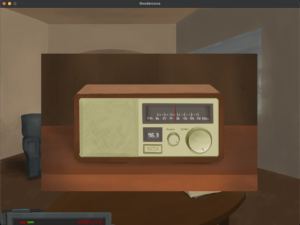 Puzzle 2 Solution – Secret Radio Frequency is 96.3. Press Seek to Advance.
Puzzle 2 Solution – Secret Radio Frequency is 96.3. Press Seek to Advance.
Next Steps
As this version of Desdemona is a vertical slice, we feel that the next steps would primarily involve improving the current mechanics, as opposed to adding new ones, and simply extending the game.
In particular, we would like to rework the conversational agent to be more responsive and adaptive to the player’s messages (possibly by using NLP). We would also like to give player’s the ability to revisit text popups, such as a diary or log of events, to give them more autonomy in the game.
In the future, we would like to offer a more extended introduction to the game, framing the narrative around a particular character with a history in the town of Desdemona. This includes giving the player more introductory context about why the main character was chosen for this mission. We would also like to extend the narrative further into the future, perhaps with more opportunities to converse with spectral entities on the parascope, add additional puzzles to solve in other locations in the city, and revisit additional artifacts from our vertical slice (like the chest or music box). We feel that the core mystery of Desdemona is engaging, but in future work, we’d like to really drill down more into it and deliver both all the necessary setup and its payoff.


